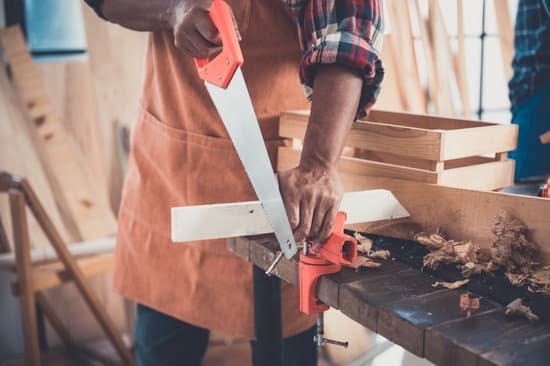Are you interested in honing your woodworking skills? Learning how to be a better woodworker is a fulfilling journey that involves understanding the basics of woodworking, perfecting techniques, and continuously learning and improving. In this article, we will explore the fundamental aspects of woodworking and provide valuable tips on how to enhance your woodworking skills.
Woodworking requires a solid foundation in the basics, starting with an introduction to various tools and materials used in the craft. Understanding the different types of wood, grain patterns, and quality is essential for creating successful woodworking projects. Additionally, mastering cutting, joinery, and finishing techniques is crucial for creating professional-level woodworking pieces.
Furthermore, safety should always be a top priority when working with wood. Protecting yourself and others from potential hazards is crucial for a safe and enjoyable woodworking experience. By learning from experienced woodworkers and continuously building your skill set, you can elevate your craftsmanship to new heights. With careful project planning, problem-solving skills, and dedication to continuous learning, you can become a better woodworker and take your creations to the next level.
Understanding Wood
Woodworking is a craft that requires a deep understanding of the material being used. Different types of wood have different characteristics, and knowing how to work with each type is essential for any woodworker. Some common types of wood include oak, maple, cherry, and pine, each with its own unique grain patterns and workability.
When working with wood, it’s important to understand the grain of the piece you are using. The grain refers to the pattern of the wood fibers, and it can have a significant impact on how the wood will behave when cut or shaped. For example, cutting across the grain can result in splintering and tear-out, while cutting with the grain can result in smoother surfaces.
In addition to understanding the types and grain of wood, quality also plays a crucial role in woodworking. High-quality wood not only looks better but also tends to be more stable and easier to work with. When selecting wood for a project, it’s important to inspect it for defects such as knots, cracks, or warping. Choosing high-quality wood will not only make your projects look better but also make them easier to work on.
- Learn about different types of wood and their characteristics
- Understand how grain patterns affect woodworking
- Select high-quality wood for your projects
Perfecting Your Techniques
When it comes to perfecting your woodworking techniques, there are three key areas to focus on: cutting, joinery, and finishing. These aspects can make a significant difference in the quality and overall appearance of your woodwork projects. To be a better woodworker, it’s important to master these techniques and understand how they contribute to the end result of your creations.
First and foremost, mastering the art of cutting is essential for any woodworker. Whether you’re using a hand saw, table saw, or jigsaw, precision is key. Understanding different types of cuts and how they impact the wood is crucial for creating clean and accurate pieces for your projects. Utilizing proper cutting techniques will not only improve the look of your work but also save you time and materials in the long run.
Joinery is another fundamental aspect of woodworking that contributes to the strength and durability of your finished pieces. Whether you’re using traditional dovetail joints or modern pocket hole screws, understanding how different joinery methods work and when to use them is crucial. Learning about various types of joints, their purposes, and how to execute them effectively will elevate the quality of your woodworking projects.
Lastly, finishing touches can truly make or break a woodworking project. From sanding and staining to applying a protective finish, understanding the intricacies of finishing techniques is vital for achieving professional results. Knowing which finishes work best with different types of wood and how to apply them properly will greatly enhance the final appearance and longevity of your creations.
To continue honing your skills in cutting, joinery, and finishing techniques as a woodworker, consider learning from experienced craftsmen in these specific areas. Take classes or workshops focused on these aspects or seek out mentorship from seasoned woodworkers who have mastered these techniques. Continuous learning through practice and seeking guidance from those with expertise will undoubtedly help you become a better woodworker over time.
- Master precision cutting techniques with various saws
- Understand different joinery methods for maximum strength
- Learn about various finishes & their applications for optimal results
Safety First
Woodworking can be a rewarding and fulfilling hobby or profession, but it also comes with potential risks. Prioritizing safety in the workshop is crucial for any woodworker, whether you are just starting out or have years of experience. By following best practices, you can protect yourself and others from accidents and injuries.
Personal Protective Equipment (PPE)
One of the most important aspects of woodworking safety is wearing the appropriate personal protective equipment (PPE). This includes safety goggles to protect your eyes from flying debris, ear protection to prevent hearing damage from loud power tools, and a respirator to avoid inhaling harmful dust particles. Additionally, wearing gloves and sturdy footwear can provide added protection.
Workshop Organization and Maintenance
A clean and well-organized workshop is essential for ensuring a safe woodworking environment. Keep your work area free of clutter and debris to avoid tripping hazards. Regularly maintain your tools and equipment to prevent malfunctions or accidents caused by faulty machinery. It’s also important to have proper ventilation in your workspace to minimize exposure to potentially harmful fumes from wood stains, finishes, and other chemicals.
Educate Yourself on Tool Safety
Before using any woodworking tool, it’s vital to familiarize yourself with its proper operation and safety features. Always read the manufacturer’s instructions for each tool before using it. Pay attention to warning labels and take the time to understand how each tool should be used safely. When using power tools, make sure they are in good working condition, with all guards and safety features intact.
By implementing these best practices for safety in your woodworking endeavors, you can create a secure and productive environment in which to develop your skills as a woodworker.
Building Your Skill Set
Seeking Mentorship
One of the most effective ways to improve your woodworking skills is by learning from experienced woodworkers. Whether it’s through a formal apprenticeship, casual mentoring, or attending workshops and classes, having an experienced mentor can provide valuable insight and guidance. Look for local woodworking clubs or online communities where you can connect with seasoned woodworkers who are willing to share their knowledge and expertise.
Observing and Emulating
Watching skilled woodworkers in action can also help you improve your techniques. Consider visiting woodworking shows, furniture exhibitions, or even just observing professionals at work in their own shops. Take note of their methods and practices, and try to incorporate what you’ve observed into your own woodworking projects. Additionally, studying the work of renowned woodworkers through books, magazines, and online resources can provide inspiration and serve as a guide for improving your craftsmanship.
Networking Within the Woodworking Community
Engaging with other woodworkers not only provides opportunities for learning from their experiences but also allows for collaboration on projects and the sharing of ideas. Joining woodworking forums, attending local meetups, or participating in group builds are great ways to connect with other enthusiasts who can offer support and advice. By building a network within the woodworking community, you’ll have access to a wealth of collective knowledge that can aid in your journey to becoming a better woodworker.
By actively seeking out mentorship, observing skilled artisans at work, and building connections within the woodworking community, you can accelerate your growth as a woodworker. These approaches provide invaluable opportunities for learning from others while also fostering a sense of camaraderie within the craft. With dedication and an openness to continuous improvement, you’ll be well-equipped to enhance your woodworking skills and become a better woodworker.
Project Planning
When it comes to woodworking, successful project planning is key to achieving a well-crafted and professional-looking piece. The process from design to execution involves careful consideration of factors such as measurements, materials, and techniques. A well-thought-out plan not only ensures the success of your project but also enhances your skills as a woodworker.
First and foremost, before diving into a woodworking project, it’s important to have a clear and detailed design in mind. Whether you are following a pre-existing plan or creating your own, having precise measurements and a thorough understanding of the project scope is essential. This stage allows you to visualize the finished product and make any necessary adjustments before starting the actual construction.
Once the design phase is complete, it’s time to move on to selecting the appropriate materials and tools for your woodworking project. Understanding the properties of different types of wood and knowing how they will react to various cutting and finishing techniques will greatly impact the quality of your final piece.
Additionally, ensuring that you have all the necessary tools and equipment for the job will streamline the execution process. Knowing how to be a better woodworker involves meticulous attention to detail in every step of the project.
| Woodworking Project Planning | Key Considerations |
|---|---|
| Design Phase | Precise measurements, clear visualization |
| Materials and Tools Selection | Understanding wood properties, having necessary tools |
Problem-Solving
As you progress in your woodworking journey, you will inevitably encounter common issues that may arise during various projects. Whether it’s a wobbly table or a joint that just won’t fit together, knowing how to troubleshoot these problems is essential in becoming a better woodworker.
One of the most common woodworking issues is wood warping. This can occur when the moisture content within the wood is not properly balanced, leading to the material bending or twisting. To prevent this, it’s important to store your wood in a climate-controlled environment and acclimate it before using it in any project. Additionally, using proper sealing techniques and finishes can help minimize the risk of warping.
Another common problem is tear-out when cutting or planing wood. This occurs when the wood fibers tear rather than being cleanly cut, resulting in a rough surface. To avoid tear-out, it’s crucial to use sharp blades and take shallow cuts. Additionally, using a backing board or sacrificial piece of wood can help support the fibers and reduce tear-out.
Lastly, an issue many woodworkers face is joints that don’t fit properly or are too loose. This can be solved by ensuring precise measurements and using high-quality tools for accurate cuts. Additionally, experimenting with different joinery techniques and understanding how wood expands and contracts with changes in humidity can help improve joint fitting.
| Common Woodworking Issue | Troubleshooting Tips |
|---|---|
| Wood Warping | Store wood in a climate-controlled environment; acclimate before use; use proper sealing techniques |
| Tear-Out During Cutting/Planing | Use sharp blades; take shallow cuts; use backing board/sacrificial piece of wood for support |
| Poor Joint Fitting | Ensure precise measurements; use high-quality tools; understand wood movement due to humidity changes |
Honing Your Craft
In conclusion, honing your craft in woodworking is a continuous journey of learning and improvement. As you have now familiarized yourself with the basics of woodworking tools and materials, understood the importance of wood types, grain, and quality, perfected your cutting, joinery, and finishing techniques, prioritized safety best practices, learned from experienced woodworkers, planned and executed various projects, and troubleshooted common woodworking issues, it’s time to focus on continuous learning and improvement.
One way to become a better woodworker is to constantly seek out opportunities to learn from more experienced woodworkers. Whether it’s through joining a local woodworking club or attending workshops and classes, surrounding yourself with others who are passionate about the craft will not only provide valuable knowledge but also help you stay motivated and inspired.
Furthermore, don’t be afraid to challenge yourself with new projects that push your skill set. This could involve tackling different types of joinery or experimenting with advanced finishes. By constantly pushing your boundaries and seeking out new challenges, you’ll continue to grow as a woodworker and further develop your abilities.
In addition, staying updated on new techniques and tools through books, online resources, or woodworking publications will also contribute to your growth as a skilled craftsman. Remember that being a better woodworker is not just about the end product but also about the journey of continued learning and improvement.
Frequently Asked Questions
How Can I Improve My Woodwork Skills?
To improve your woodwork skills, it’s important to practice regularly and seek out learning opportunities. Consider taking classes or workshops, watching tutorials, and studying different techniques. Additionally, invest in quality tools and materials to work with.
How Do I Become a Good Woodworker?
Becoming a good woodworker takes time and dedication. Start by learning the basics of woodworking such as measuring, cutting, and joining pieces together. Focus on building your foundational skills before moving on to more advanced projects. Don’t be afraid to make mistakes – they are part of the learning process.
Is Woodworking a High Income Skill?
Woodworking can potentially be a high-income skill, especially for those who have honed their craft and developed a strong portfolio of work. Skilled woodworkers who can create high-quality custom pieces or offer specialized services often command higher rates for their work. Like any profession, success in woodworking requires skill, experience, and business acumen.

Hi everyone! I’m a woodworker and blogger, and this is my woodworking blog. In my blog, I share tips and tricks for woodworkers of all skill levels, as well as project ideas that you can try yourself.





